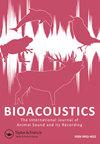传统与创新:比较生物声学和雾网结果与蝙蝠取样
IF 1.5
4区 生物学
Q2 ZOOLOGY
Bioacoustics-The International Journal of Animal Sound and Its Recording
Pub Date : 2022-01-06
DOI:10.1080/09524622.2021.2008494
引用次数: 7
摘要
蝙蝠是一个复杂多样的群体,这使得蝙蝠的研究极具挑战性。有几种方法可以研究蝙蝠,例如雾网和声学监测(AM)。我们比较了在巴西圣保罗州山区使用AM和雾网清点蝙蝠的情况。我们提供了一份基于两种方法登记的物种的研究区域物种清单,并与从文献中获得的该州已知物种清单进行了比较。我们计算了不同方法之间的β多样性,以评估用这些方法采样的物种组成的差异。我们还进行了主成分分析,以评估AM采样的蝙蝠动物群是否显示出物种栖息地关联。我们通过AM记录了15种/声型,通过雾网记录了22种。β多样性揭示了97%的物种组成差异。营业额部分解释了这种差异的96%。PCA显示,Vespertionidae蝙蝠与边界/杂乱的栖息地有关,而Molossidae蝙蝠存在于所有栖息地类型中。该州的物种清单包括80种。我们的库存记录了超过25%的这种动物。雾网对低空飞行/低强度回声定位蝙蝠的采样非常有效。AM对于高飞行/高强度回声定位蝙蝠的采样至关重要。这是第二项使用AM对该州蝙蝠进行盘点的研究。本文章由计算机程序翻译,如有差异,请以英文原文为准。
Tradition vs. innovation: comparing bioacoustics and mist-net results to bat sampling
ABSTRACT Bats are a complex and diverse group, making their study remarkably challenging. Several methods allow the study of bats, e.g. mist-nets and acoustic monitoring (AM). We compare the use of AM and mist-nets to inventory bats in a mountainous region of São Paulo state, Brazil. We provide a species list for the study area based on species registered with both methodologies, comparing with a species list known for the state, obtained from the literature. We calculated beta diversity between methodologies to evaluate the dissimilarity in species composition sampled with these methods. We also performed a PCA to evaluate if the bat fauna sampled with AM showed species-habitat associations. We recorded 15 species/sonotypes through AM and 22 species through mist-nets. Beta diversity revealed 97% of dissimilarity in species composition. The turnover component explained 96% of this dissimilarity. PCA revealed that Vespertilionidae bats were associated with border/cluttered habitats, while Molossidae bats were present in all habitat types. The species list for the state comprises eighty species. Our inventory recorded more than 25% of this fauna. Mist-nets are efficient for sampling low-flying/low-intensity echolocating bats. AM is crucial for sampling high-flying/high-intensity echolocating bats. This is the second study to use AM to inventory bats in this state.
求助全文
通过发布文献求助,成功后即可免费获取论文全文。
去求助
来源期刊
CiteScore
4.50
自引率
0.00%
发文量
25
审稿时长
>12 weeks
期刊介绍:
Bioacoustics primarily publishes high-quality original research papers and reviews on sound communication in birds, mammals, amphibians, reptiles, fish, insects and other invertebrates, including the following topics :
-Communication and related behaviour-
Sound production-
Hearing-
Ontogeny and learning-
Bioacoustics in taxonomy and systematics-
Impacts of noise-
Bioacoustics in environmental monitoring-
Identification techniques and applications-
Recording and analysis-
Equipment and techniques-
Ultrasound and infrasound-
Underwater sound-
Bioacoustical sound structures, patterns, variation and repertoires

 求助内容:
求助内容: 应助结果提醒方式:
应助结果提醒方式:


